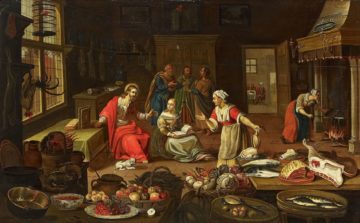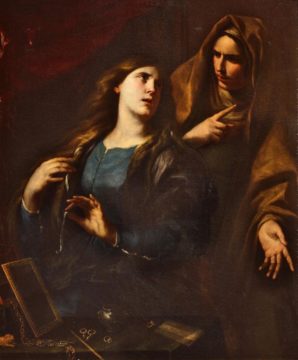Franciscan Friar Fr. Paul Gallagher reflects on the Gospel for the Sixteenth Sunday of Ordinary Time, July 17, 2022. The content is edited by Franciscan Sister of Christian Charity Sister Anne Marie Lom and Joe Thiel. The excerpts from the Sunday readings are prepared by Joe Thiel. To read or download the complete pdf with excerpts for your prayer, please click here: Franciscan Gospel Reflection July 17 2022. Excerpts are from the Lectionary for Mass for Use in the Dioceses of the United States of America, second typical edition © 2001, 1998, 1997, 1986, 1970 Confraternity of Christian Doctrine, Inc., Washington, DC. Used with permission. All rights reserved. No portion of this text may be reproduced by any means without permission in writing from the copyright owner. Photo: Andrea Vaccaro, Public domain, via Wikimedia Commons; https://commons.wikimedia.org/wiki/File:Andrea_Vaccaro_-_Martha_and_Mary.jpg By attributed to Georg Friedrich Stettner († 1639) – Van Ham Kunstauktionen, Public Domain, https://commons.wikimedia.org/w/index.php?curid=22784265
Luke 10:38-42
[As they continued their journey,] Jesus entered a village where a woman whose name was Martha welcomed him. She had a sister named Mary who sat beside the Lord at his feet listening to him speak. Martha, burdened with much serving, came to him and said, “Lord, do you not care that my sister has left me by myself to do the serving? Tell her to help me.” The Lord said to her in reply, “Martha, Martha, you are anxious and worried about many things. There is need of only one thing. Mary has chosen the better part and it will not be taken from her.”
Background:
Last week’s gospel text ended with Jesus telling the familiar parable of the Good Samaritan. It was told by Jesus in response to a scholar of the law who wanted to justify himself and wanted Jesus to define who should be considered one’s neighbor. Luke places this account of Martha and Mary right after the parable of the Good Samaritan.
Often Mary and Martha are understood as representing two types of service or models of discipleship. Martha is seen as representing the active ministry, and Mary represents the contemplative ministry of prayer and study. While this line of reflection may be very helpful for many, it seems to miss what would have been most apparent to the people of Luke’s community. In the text, Jesus is welcomed into the home and company of two women without the protective presence of another male of authority. In Jesus’ day, it was very unusual for a woman to own property, and it would draw attention if unaccompanied women would have a male enter the house. Jesus ignores the norms of appropriate behavior and the expectation of maintaining separate and appropriate space in relationships between men and women. Traditionally men inhabited the public spaces, in the community and within the homes. Women were expected to stay separated, going to the well in the early morning, and otherwise remaining in the kitchen and the private places of the house.
In the gospel as Luke presents it, Jesus enters the house where Martha and Mary are present. It is possible that Lazarus is present, but Luke does not mention his presence. That is a detail that one might expect to be included, given the possibility of scandal for the people of the day. Also, the usual custom would have been for Lazarus to be the one to greet Jesus and sit with him, while the two women attended to the other duties of hospitality. Instead, Luke describes Mary as sitting at the feet of Jesus listening to his teaching, in the customary positions of a teacher and disciple. Martha is described as performing the traditional role of hospitality for women of the day and the traditional responsibilities of female disciples. Think of Peter’s mother-in-law who, when healed, as reported by Luke, “She got up immediately and waited on them.” (Luke 4:39b)
It is impossible to know what is motivating Martha to make her comment to Jesus, or why she did not address her concern to Mary directly. On another level, we have the story as Luke has placed it in his gospel, with the details of the situation that he has chosen to include, and without those he has chosen to exclude. The fact that Luke includes this encounter of Jesus with Martha and Mary right after he had told the parable of the Good Samaritan also seems to be significant and to add meaning to this short text.
Reflection Questions:
- Have there been occasions when gender roles have affected others’ expectations of you or others? What was your internal reaction? What was your external reaction?
- How do you live within a society and a church that has gender roles?
- Do you think that by including this short text of Jesus’s visit with Mary and Martha, Luke was challenging the gender roles of the early Christians?
- The fact that Jesus is willing to accept the hospitality of two women and Luke is able to record the incident in his gospel says to me…
- When I hear in the gospel Martha complaining about what Mary is not doing, I am reminded of…
- Does the fact that Luke has placed this story right after the parable of the Good Samaritan seem to emphasize certain qualities for you of this account?
- Can you take some time now to talk with Jesus about how he responded to Martha and Mary in this account, perhaps especially any way you find yourself surprised by the account, or about your own relationship with God at this point in your life?


